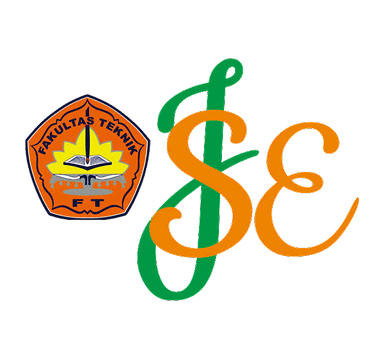Enhanced In-Situ Bioremediation of Petroleum-Contaminated Soil: A Review
Keywords:
biodegradation, column test, in situ bioremediation, petroleum, soilAbstract
Petroleum is still one of the main sources of energy even though many energy sources have been discovered today. The growing petroleum industry is directly proportional to the contamination that can be caused by this industry. Bioremediation is an environmentally friendly and cost-effective technology that has recently become a favorite technology in dealing with petroleum contaminated soil waste. This technology can be carried out directly in the polluted area, to minimize dredging and transportation costs. However, natural attenuation has limited potential and needs a longer time to degrade hydrocarbon. The article aims to outline the application and factors to consider in in-situ bioremediation of petroleum-contaminated soil.
References
[1] S. Abdulsalam, I. M. Bugaje, S. S. Adefila, and S. Ibrahim, “Comparison of biostimulation and bioaugmentation for remediation of soil contaminated with spent motor oil,” International Journal of Environmental Science and Technology, vol. 8, no. 1, 2011, doi: 10.1007/BF03326208.
[2] Q. Helmy, R. Laksmono, and E. Kardena, “Bioremediation of Aged Petroleum Oil Contaminated Soil: From Laboratory Scale to Full Scale Application,” Procedia Chem, vol. 14, pp. 326–333, 2015, doi: 10.1016/j.proche.2015.03.045.
[3] A. Lahel et al., “Effect of process parameters on the bioremediation of diesel contaminated soil by mixed microbial consortia,” Int Biodeterior Biodegradation, vol. 113, pp. 375–385, Sep. 2016, doi: 10.1016/j.ibiod.2016.05.005.
[4] S.-Y. Wang, Y.-C. Kuo, A. Hong, Y.-M. Chang, and C.-M. Kao, “Bioremediation of diesel and lubricant oil-contaminated soils using enhanced landfarming system,” Chemosphere, vol. 164, pp. 558–567, Dec. 2016, doi: 10.1016/j.chemosphere.2016.08.128.
[5] N. Subuntith, L. Somruetai, B. Traimat, and V. Verapong, “Bioremediation of petroleum contaminated soils by lipopeptide producing Bacillus subtilis SE1,” Afr J Biotechnol, vol. 18, no. 23, pp. 494–501, Jun. 2019, doi: 10.5897/ajb2019.16822.
[6] Y. Li et al., “Soil microbial ecological effect of shale gas oil-based drilling cuttings pyrolysis residue used as soil covering material,” J Hazard Mater, vol. 436, Aug. 2022, doi: 10.1016/j.jhazmat.2022.129231.
[7] A. Ziółkowska and M. Wyszkowski, “Toxicity of petroleum substances to microorganisms and plants,” Ecological Chemistry and Engineering S, vol. 17, no. 1, pp. 73–82, 2010.
[8] M. Hu, “Environmental Behavior of Petroleum in Soil and its Harmfulness Analysis,” IOP Conf Ser Earth Environ Sci, vol. 450, no. 1, p. 012100, Feb. 2020, doi: 10.1088/1755-1315/450/1/012100.
[9] M. Ajona and P. Vasanthi, “Bioremediation of petroleum contaminated soils – A review,” Mater Today Proc, vol. 45, pp. 7117–7122, 2021, doi: 10.1016/j.matpr.2021.01.949.
[10] M. Sathishkumar, A. R. Binupriya, S.-H. Baik, and S.-E. Yun, “Biodegradation of Crude Oil by Individual Bacterial Strains and a Mixed Bacterial Consortium Isolated from Hydrocarbon Contaminated Areas,” Clean (Weinh), vol. 36, no. 1, pp. 92–96, Jan. 2008, doi: 10.1002/clen.200700042.
[11] M. W. Lim, E. Von Lau, and P. E. Poh, “A comprehensive guide of remediation technologies for oil contaminated soil — Present works and future directions,” Mar Pollut Bull, vol. 109, no. 1, pp. 14–45, Aug. 2016, doi: 10.1016/j.marpolbul.2016.04.023.
[12] M. Ajona and P. Vasanthi, “Bioremediation of petroleum contaminated soils – A review,” in Materials Today: Proceedings, Elsevier Ltd, 2020, pp. 7117–7122. doi: 10.1016/j.matpr.2021.01.949.
[13] Y. Wang et al., “Optimization of conditions for a surfactant-producing strain and application to petroleum hydrocarbon-contaminated soil bioremediation,” Colloids Surf B Biointerfaces, vol. 213, 2022, doi: 10.1016/j.colsurfb.2022.112428.
[14] G. Casiraghi et al., “Piloting Activities for the Design of a Large-scale Biobarrier Involving In Situ Sequential Anaerobic–aerobic Bioremediation of Organochlorides and Hydrocarbons,” Water Air Soil Pollut, vol. 233, no. 10, 2022, doi: 10.1007/s11270-022-05886-1.
[15] A. S. Madison, S. J. Sorsby, Y. Wang, and T. A. Key, “Increasing in situ bioremediation effectiveness through field-scale application of molecular biological tools,” Front Microbiol, vol. 13, 2023, doi: 10.3389/fmicb.2022.1005871.
[16] B. Rahimi, H. Sadeghi, H. Moghimi, and P. Samari, Soil columns for the investigation of bioremediation and moisture distribution in vadose zone. 2023. doi: 10.1201/9781003299127-275.
[17] M. M. Joe et al., “Simultaneous application of biosurfactant and bioaugmentation with rhamnolipid-producing Shewanella for enhanced bioremediation of oil-polluted soil,” Applied Sciences (Switzerland), vol. 9, no. 18, 2019, doi: 10.3390/app9183773.
[18] F. Bosco, A. Casale, F. Chiampo, and A. Godio, “Removal of diesel oil in soil microcosms and implication for geophysical monitoring,” Water (Switzerland), vol. 11, no. 8, 2019, doi: 10.3390/w11081661.
[19] V. Kondrashina, E. Strijakova, L. Zinnatshina, E. Bocharnikova, and G. Vasilyeva, “Influence of activated carbon and other additives on bioremediation rate and characteristics of petroleum-contaminated soils,” Soil Sci, vol. 183, no. 4, pp. 150–158, 2018, doi: 10.1097/SS.0000000000000234.
[20] G. Vasilyeva, V. Kondrashina, E. Strijakova, and J.-J. Ortega-Calvo, “Adsorptive bioremediation of soil highly contaminated with crude oil,” Science of the Total Environment, vol. 706, 2020, doi: 10.1016/j.scitotenv.2019.135739.
[21] P. Bharali, S. P. Singh, Y. Bashir, N. Dutta, B. K. Konwar, and C. B. Singh, “Characterization and assessment of biosurfactant producing indigenous hydrocarbonoclastic bacteria: Potential application in bioremediation,” Nova Biotechnologica et Chimica, vol. 17, no. 2, pp. 103–114, 2018, doi: 10.2478/nbec-2018-0011.
[22] E. Moshkovich, Z. Ronen, F. Gelman, and O. Dahan, “In situ bioremediation of a gasoline-contaminated vadose zone: Implications from direct observations,” Vadose Zone Journal, vol. 17, no. 1, 2017, doi: 10.2136/vzj2017.08.0153.
[23] Z. Zhu, B. Zhang, B. Chen, Q. Cai, and W. Lin, “Biosurfactant Production by Marine-Originated Bacteria Bacillus Subtilis and Its Application for Crude Oil Removal,” Water Air Soil Pollut, vol. 227, no. 9, 2016, doi: 10.1007/s11270-016-3012-y.
[24] J. Avdalovic, A. Duric, S. Miletic, M. Ilic, J. Milic, and M. M. Vrvic, “Treatment of a mud pit by bioremediation,” Waste Management and Research, vol. 34, no. 8, pp. 734–739, 2016, doi: 10.1177/0734242X16652961.
[25] G. L. Xu et al., “In situ bioremediation of crude oil contaminated site: A case study in Jianghan oil field, China,” Pet Sci Technol, vol. 34, no. 1, pp. 63–70, 2016, doi: 10.1080/10916466.2015.1115873.
[26] M. Zargar, M. H. Sarrafzadeh, B. Taheri, and A. Keshavarz, “Assessment of in situ bioremediation of oil contaminated soil and groundwater in a petroleum refinery: A laboratory soil column study,” Pet Sci Technol, vol. 32, no. 13, pp. 1553–1561, 2014, doi: 10.1080/10916466.2012.690482.
[27] H. Lee, Y. Lee, J. Kim, and C. Kim, “Field application of modified in situ soil flushing in combination with air sparging at a military site polluted by diesel and gasoline in Korea,” Int J Environ Res Public Health, vol. 11, no. 9, pp. 8806–8824, 2014, doi: 10.3390/ijerph110908806.
[28] S. Kuppusamy, N. R. Maddela, M. Megharaj, and K. Venkateswarlu, Total Petroleum Hydrocarbons: Environmental Fate, Toxicity, and Remediation. 2019. doi: 10.1007/978-3-030-24035-6.
[29] S. Notodarmojo, Pencemaran Air Tanah dan Air Tanah, vol. 3. 2005.
[30] P. B. Bedient, H. S. Rifai, and C. J. Newell, Ground water contamination : transport and remediation. 1999.
[31] I. A. Mirsal, Soil pollution: Origin, monitoring & remediation. Springer Berlin Heidelberg, 2008. doi: 10.1007/978-3-540-70777-6.
[32] H. da Silva Correa, C. T. Blum, F. Galvão, and L. T. Maranho, “Effects of oil contamination on plant growth and development: a review,” Environmental Science and Pollution Research, vol. 29, no. 29, pp. 43501–43515, Jun. 2022, doi: 10.1007/s11356-022-19939-9.
[33] M. Wang, B. Zhang, G. Li, T. Wu, and D. Sun, “Efficient remediation of crude oil-contaminated soil using a solvent/surfactant system,” RSC Adv, vol. 9, no. 5, pp. 2402–2411, 2019, doi: 10.1039/C8RA09964B.
[34] W. Yang, “Influence of Oil Pollution on Soil Water and Fertilizer Coordination Ability,” IOP Conf Ser Earth Environ Sci, vol. 514, no. 5, p. 052037, May 2020, doi: 10.1088/1755-1315/514/5/052037.
[35] F. U. Haider et al., “Phytotoxicity of petroleum hydrocarbons: Sources, impacts and remediation strategies,” Environ Res, vol. 197, p. 111031, Jun. 2021, doi: 10.1016/j.envres.2021.111031.
[36] T. Rengarajan, P. Rajendran, N. Nandakumar, B. Lokeshkumar, P. Rajendran, and I. Nishigaki, “Exposure to polycyclic aromatic hydrocarbons with special focus on cancer,” Asian Pac J Trop Biomed, vol. 5, no. 3, pp. 182–189, Mar. 2015, doi: 10.1016/S2221-1691(15)30003-4.
[37] H. Kamani et al., “Health risk assessment of BTEX compounds (benzene, toluene, ethylbenzene and xylene) in different indoor air using Monte Carlo simulation in zahedan city, Iran.,” Heliyon, vol. 9, no. 9, p. e20294, Sep. 2023, doi: 10.1016/j.heliyon.2023.e20294.
[38] A. S. Nwankwegu and C. O. Onwosi, “Bioremediation of gasoline contaminated agricultural soil by bioaugmentation,” Environ Technol Innov, vol. 7, pp. 1–11, Apr. 2017, doi: 10.1016/j.eti.2016.11.003.
[39] T. Cheng, J. Liang, J. He, X. Hu, Z. Ge, and J. Liu, “A novel rhamnolipid-producing Pseudomonas aeruginosa ZS1 isolate derived from petroleum sludge suitable for bioremediation,” AMB Express, vol. 7, no. 1, p. 120, Dec. 2017, doi: 10.1186/s13568-017-0418-x.
[40] X. Chen, G. Shan, J. Shen, F. Zhang, Y. Liu, and C. Cui, “In situ bioremediation of petroleum hydrocarbon–contaminated soil: isolation and application of a Rhodococcus strain,” International Microbiology, vol. 26, no. 2, pp. 411–421, Dec. 2022, doi: 10.1007/s10123-022-00305-1.
[41] S. Covino et al., “Assessment of degradation potential of aliphatic hydrocarbons by autochthonous filamentous fungi from a historically polluted clay soil,” Science of The Total Environment, vol. 505, pp. 545–554, Feb. 2015, doi: 10.1016/j.scitotenv.2014.10.027.
[42] J. T. Cookson, Bioremediation Engineering : Design and Application. McGraw-Hill, Inc, 1995.
[43] S. Wang, Y. Xu, Z. Lin, J. Zhang, N. Norbu, and W. Liu, “The harm of petroleum-polluted soil and its remediation research,” 2017, p. 020222. doi: 10.1063/1.4993039.
[44] M. Guirado et al., “Effectiveness of biochar application and bioaugmentation techniques for the remediation of freshly and aged diesel-polluted soils,” Int Biodeterior Biodegradation, vol. 163, p. 105259, Sep. 2021, doi: 10.1016/j.ibiod.2021.105259.
[45] Z. Liu, Z. Li, S. Chen, and W. Zhou, “Enhanced phytoremediation of petroleum-contaminated soil by biochar and urea,” J Hazard Mater, vol. 453, p. 131404, Jul. 2023, doi: 10.1016/J.JHAZMAT.2023.131404.
[46] R. Margesin and F. Schinner, “Biodegradation and bioremediation of hydrocarbons in extreme environments,” Appl Microbiol Biotechnol, vol. 56, no. 5–6, pp. 650–663, Sep. 2001, doi: 10.1007/s002530100701.
[47] R. L. Rhykerd, R. W. Weaver, and K. J. Mcinnes, “Influence of Salinity on Bioremediation of Oil in Soil,” Environmental Pollution, vol. 90, pp. 127–130, 1994.
[48] E. Atai, R. B. Jumbo, T. Cowley, I. Azuazu, F. Coulon, and M. Pawlett, “Efficacy of bioadmendments in reducing the influence of salinity on the bioremediation of oil-contaminated soil,” Science of The Total Environment, vol. 892, p. 164720, Sep. 2023, doi: 10.1016/J.SCITOTENV.2023.164720.
[49] X. Qin, J. C. Tang, D. S. Li, and Q. M. Zhang, “Effect of salinity on the bioremediation of petroleum hydrocarbons in a saline-alkaline soil,” Lett Appl Microbiol, vol. 55, no. 3, pp. 210–217, Sep. 2012, doi: 10.1111/j.1472-765X.2012.03280.x.
[50] A. Carolina Feitosa de Vasconcelos, “Biochar Effects on Amelioration of Adverse Salinity Effects in Soils,” in Applications of Biochar for Environmental Safety, IntechOpen, 2020. doi: 10.5772/intechopen.92464.
[51] X. Lee et al., “Use of biochar to manage soil salts and water: Effects and mechanisms,” Catena (Amst), vol. 211, p. 106018, Apr. 2022, doi: 10.1016/J.CATENA.2022.106018.
[52] J. Sharma, D. Sundar, and P. Srivastava, “Biosurfactants: Potential Agents for Controlling Cellular Communication, Motility, and Antagonism,” Front Mol Biosci, vol. 8, Oct. 2021, doi: 10.3389/fmolb.2021.727070.
[53] R. Jahan, A. M. Bodratti, M. Tsianou, and P. Alexandridis, “Biosurfactants, natural alternatives to synthetic surfactants: Physicochemical properties and applications,” Adv Colloid Interface Sci, vol. 275, p. 102061, Jan. 2020, doi: 10.1016/j.cis.2019.102061.
[54] M. Pacwa-Płociniczak, G. A. Płaza, Z. Piotrowska-Seget, and S. S. Cameotra, “Environmental Applications of Biosurfactants: Recent Advances,” Int J Mol Sci, vol. 12, no. 1, pp. 633–654, Jan. 2011, doi: 10.3390/ijms12010633.
[55] J. Xu, Z. Cao, F. Chen, Y. Li, J. Dai, and X. Zhang, “Fast degradation of macro alkanes through activating indigenous bacteria using biosurfactants produced by Burkholderia sp.,” Environmental Science and Pollution Research, vol. 30, no. 23, pp. 64300–64312, Apr. 2023, doi: 10.1007/s11356-023-26909-2.
[56] S. Zhang et al., “Enhanced degradation of petroleum in saline soil by nitrogen stimulation and halophilic emulsifying bacteria Bacillus sp. Z-13,” J Hazard Mater, vol. 459, p. 132102, Oct. 2023, doi: 10.1016/j.jhazmat.2023.132102.
[57] J. G. Leahy and R. R. Colwell, “Microbial degradation of hydrocarbons in the environment,” Microbiol Rev, vol. 54, no. 3, pp. 305–315, Sep. 1990, doi: 10.1128/mr.54.3.305-315.1990.
[58] N. Alavi et al., “Biodegradation of Petroleum Hydrocarbons in a Soil Polluted Sample by Oil-Based Drilling Cuttings,” Soil and Sediment Contamination: An International Journal, vol. 23, no. 5, pp. 586–597, Jan. 2014, doi: 10.1080/15320383.2014.847900.
[59] W. Wang et al., “Dose–effect of nitrogen regulation on the bioremediation of diesel contaminated soil,” Environ Technol Innov, vol. 32, p. 103245, Nov. 2023, doi: 10.1016/J.ETI.2023.103245.
[60] H. Liu, H. Gao, M. Wu, C. Ma, J. Wu, and X. Ye, “Distribution Characteristics of Bacterial Communities and Hydrocarbon Degradation Dynamics During the Remediation of Petroleum-Contaminated Soil by Enhancing Moisture Content,” Microb Ecol, vol. 80, no. 1, pp. 202–211, Jul. 2020, doi: 10.1007/s00248-019-01476-7.
[61] S.-H. Lee, W. Ji, D. M. Kang, and M.-S. Kim, “Effect of soil water content on heavy mineral oil biodegradation in soil,” J Soils Sediments, vol. 18, no. 3, pp. 983–991, Mar. 2018, doi: 10.1007/s11368-017-1849-3.
[62] S. N. Singh, B. Kumari, and S. Mishra, “Microbial Degradation of Alkanes,” 2012, pp. 439–469. doi: 10.1007/978-3-642-23789-8_17.
[63] G. Kebede, T. Tafese, E. M. Abda, M. Kamaraj, and F. Assefa, “Factors Influencing the Bacterial Bioremediation of Hydrocarbon Contaminants in the Soil: Mechanisms and Impacts,” J Chem, vol. 2021, pp. 1–17, Nov. 2021, doi: 10.1155/2021/9823362.
[64] EPA, “Enhanced Aerobic Bioremediation,” in How To Evaluate Alternative Cleanup Technologies For Underground Storage Tank Sites, vol. VII, 2004.
[65] S. An, H. Woo, S. H. Kim, S.-T. Yun, J. Chung, and S. Lee, “Complex behavior of petroleum hydrocarbons in vadose zone: A holistic analysis using unsaturated soil columns,” Chemosphere, vol. 326, 2023, doi: 10.1016/j.chemosphere.2023.138417.
[66] Y. Sun, Y. Liu, G. Yue, J. Cao, C. Li, and J. Ma, “Vapor-phase biodegradation and natural attenuation of petroleum VOCs in the unsaturated zone: A microcosm study,” Chemosphere, vol. 336, p. 139275, Sep. 2023, doi: 10.1016/j.chemosphere.2023.139275.
[67] I. G. S. da Silva, F. C. G. de Almeida, N. M. P. da R. E Silva, J. T. R. de Oliveira, A. Converti, and L. A. Sarubbo, “Application of green surfactants in the remediation of soils contaminated by hydrocarbons,” Processes, vol. 9, no. 9, 2021, doi: 10.3390/pr9091666.
[68] W. C. Anderson, “innovative site remediation technology: Bioremediation,” American Academy of Environmental Engineers, Annapolis, vol. 1, 1995.
[69] E. M. Semenova et al., “Crude Oil Degradation in Temperatures Below the Freezing Point by Bacteria from Hydrocarbon-Contaminated Arctic Soils and the Genome Analysis of Sphingomonas sp. AR_OL41,” Microorganisms, vol. 12, no. 1, p. 79, Dec. 2023, doi: 10.3390/microorganisms12010079.
[70] H. S. Yap, N. N. Zakaria, A. Zulkharnain, S. Sabri, C. Gomez-Fuentes, and S. A. Ahmad, “Bibliometric Analysis of Hydrocarbon Bioremediation in Cold Regions and a Review on Enhanced Soil Bioremediation,” Biology (Basel), vol. 10, no. 5, p. 354, Apr. 2021, doi: 10.3390/biology10050354.
[71] M. M. Mohammadi-Sichani, M. M. Assadi, A. Farazmand, M. Kianirad, A. M. Ahadi, and H. H. Ghahderijani, “Bioremediation of soil contaminated crude oil by Agaricomycetes,” J Environ Health Sci Eng, vol. 15, no. 1, 2017, doi: 10.1186/s40201-016-0263-x.
[72] C.-Y. Ke et al., “Biotreatment of oil sludge containing hydrocarbons by Proteus mirabilis SB,” Environ Technol Innov, vol. 23, 2021, doi: 10.1016/j.eti.2021.101654.
[73] L. S. Khudur, E. Shahsavari, A. F. Miranda, P. D. Morrison, D. Nugegoda, and A. S. Ball, “Evaluating the efficacy of bioremediating a diesel-contaminated soil using ecotoxicological and bacterial community indices,” Environmental Science and Pollution Research, vol. 22, no. 19, pp. 14809–14819, Oct. 2015, doi: 10.1007/s11356-015-4624-2.
[74] L. S. Khudur, E. Shahsavari, G. T. Webster, D. Nugegoda, and A. S. Ball, “The impact of lead co-contamination on ecotoxicity and the bacterial community during the bioremediation of total petroleum hydrocarbon-contaminated soils,” Environmental Pollution, vol. 253, pp. 939–948, Oct. 2019, doi: 10.1016/j.envpol.2019.07.107.
[75] M. Wyszkowski and N. Kordala, “Trace Element Contents in Petrol-Contaminated Soil Following the Application of Compost and Mineral Materials,” Materials, vol. 15, no. 15, p. 5233, Jul. 2022, doi: 10.3390/ma15155233.
[76] X. Wang, X. Wang, F. Wu, J. Zhang, S. Ai, and Z. Liu, “Microbial community composition and degradation potential of petroleum-contaminated sites under heavy metal stress,” J Hazard Mater, vol. 457, p. 131814, Sep. 2023, doi: 10.1016/j.jhazmat.2023.131814.
Downloads
Published
Issue
Section
License
Copyright (c) 2024 Rizka Amelia Situmorang, Qomarudin Helmy (Author)

This work is licensed under a Creative Commons Attribution 4.0 International License.












